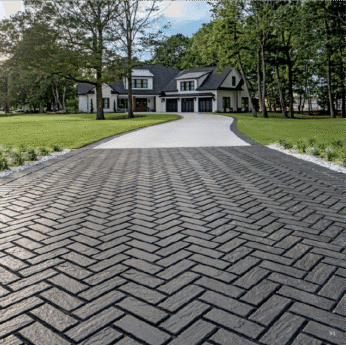June 20, 2025
How to Remove Stains from Pavers

Pavers are a beautiful addition to any outdoor space, offering durability, aesthetic appeal, and low maintenance. But no matter how high the quality, pavers can become stained over time due to weather, spills, or foot traffic. Whether you’re a homeowner trying to restore the look of your patio, or a contractor maintaining a commercial property, understanding how to remove stains from pavers is crucial.
As the Best Pavers Seller Canada relies on for premium materials and expert advice, we’re here to guide you through the top stain-removal methods, maintenance tips, and how to keep your pavers looking brand new for years.
Understanding the Types of Stains on Pavers
Before diving into solutions, it’s important to identify the type of stain you’re dealing with. Common stains on pavers include:
Oil and grease stains – Often from vehicles or grills.
Rust stains – Caused by metal furniture or fertilizer.
Organic stains – From leaves, moss, bird droppings, or tree sap.
Efflorescence – A white powdery deposit from water movement through pavers.
Paint or dye stains – From DIY accidents or construction work.
Each type of stain requires a specific treatment, and using the wrong method may damage your pavers.
General Preparation Before Cleaning
Here’s what to do before attempting stain removal:
Sweep the area – Remove loose dirt and debris.
Wet the surrounding area – This prevents cleaning products from soaking too deeply.
Test any cleaner – Always try your cleaning method on a small, hidden section first.
How to Remove Common Paver Stains
1. Oil and Grease Stains
Method: Dish Soap + Hot Water
Mix dish soap with hot water and apply it to the stain.
Scrub with a stiff-bristled brush.
Rinse thoroughly with water.
For tougher stains, use a degreaser specifically designed for pavers. Avoid using acids, as they can damage the paver surface.
Pro Tip: Ask your supplier. As the Best Pavers Seller Canada offers, we recommend oil-resistant sealers to prevent future stains.
2. Rust Stains
Method: Commercial Rust Removers
Use a pH-balanced rust remover designed for natural stone or concrete.
Apply as directed and scrub gently.
Avoid: Harsh acids like muriatic acid can damage the paver surface or discolor them.
3. Organic Stains (Leaves, Moss, Mold, Bird Droppings)
Method: Oxygenated Bleach Solution
Mix oxygen bleach (not chlorine bleach) with water.
Pour over the stained area.
Let it sit for 10–15 minutes, then scrub and rinse.
This is a safe and eco-friendly solution that doesn’t harm nearby plants.
4. Paint or Dye Stains
Method: Paint Remover or Pressure Washer
For latex paint, a paint remover or rubbing alcohol can help.
For oil-based paint, you may need a stronger paint stripper.
Warning: Always avoid scraping the pavers, as it can cause surface damage.
5. Efflorescence
Method: Specialized Efflorescence Remover
Available at most Best Pavers Seller Canada retailers.
Apply as directed and rinse thoroughly.
Efflorescence is temporary and will usually stop after a few months. Sealing pavers after cleaning can help prevent its recurrence.
Pressure Washing Pavers – Dos and Don’ts
Do:
Use a pressure washer with a fan tip nozzle.
Keep a safe distance (12 inches) from the pavers.
Sweep sand back into the joints after washing.
Don’t:
Use excessive pressure, which can chip or loosen pavers.
Ignore re-sealing the surface, especially after power washing.
The Importance of Sealing Pavers
Once you’ve cleaned your pavers, sealing them offers long-term protection:
Prevents stains from penetrating the surface
Enhances the color and texture
Reduces weed and moss growth
Protects from UV damage and water absorption
Most Best Pavers Seller Canada options recommend sealing once every 2–3 years, depending on foot traffic and climate.
Maintenance Tips to Prevent Future Stains
Clean spills immediately – Especially oil or wine.
Sweep regularly – To remove organic debris.
Use mats under grills or furniture – To catch grease or rust.
Trim nearby plants – Reduces sap and leaf litter.
Reapply sealant – Protects against absorption of moisture and stains.
Why Choose the Best Pavers Seller Canada?
Cleaning and maintaining pavers is much easier when you start with high-quality materials. Here’s why choosing a trusted name matters:
Durability: Premium pavers are more resistant to stains and weathering.
Color Integrity: High-quality pigments reduce fading and discoloration.
Texture & Finish: A superior finish makes it easier to clean and seal.
As the Best Pavers Seller Canada has to offer, we provide not only top-tier paver products but also expert after-sales support, including:
Installation guidance
Maintenance tips
Sealant recommendations
Eco-friendly stain removal products
Final Thoughts
Pavers are an investment in the beauty and value of your home or property. Knowing how to remove stains from pavers ensures they look great for years, and by using the right techniques, tools, and cleaning solutions, you can avoid costly replacements or repairs.
When it comes to quality, always choose the Best Pavers Seller Canada trusts. Our expert team can guide you on choosing the right pavers, sealers, and stain removers to keep your property in perfect condition.
FAQs
Q: Can vinegar be used to clean pavers?
A: While vinegar can remove some stains, it’s acidic and may damage certain paver finishes. Always test first.
Q: How often should I clean my pavers?
A: Light sweeping weekly, deep cleaning seasonally, and sealing every 2–3 years is ideal.
Q: Can I use bleach to clean pavers?
A: Only oxygen bleach is recommended. Chlorine bleach can kill grass and damage pavers.
Need Expert Help?
Whether you’re looking to install new pavers or revive your old ones, contact the Best Pavers Seller Canada depends on. We provide free consultations, product recommendations, and even refer trusted installers in your area.























